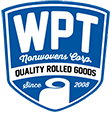Carded (Nonwoven)
Nonwovens made from carded webs that were bonded by anyone of several technologies providing fabric integrity.
Composite (Material)
Combining 2 or more distinctive-properties materials that may, though, have known interfacing qualities.
Dry Laid (Nonwoven)
Webs of fibers that are dry-laid and bonded by 1+ bonding techniques meant to introduce fabric integrity.
Hydrophilic
Propensity for wetness involving water or the absorbing thereof.
Medical grade and nonwovens
Some of the qualities that all medical fabrics must subscribe to include softness, cleanliness, purity, strength, absorbency, resilience and adaptability. Well, it just so happens that nonwovens are ideally suited to be manufactured/engineered to provide these qualities, thus providing sterility, stretch, liquid repellency, super absorbency and bacterial barriers. Medical grade nonwovens are used for or in bedding, medical devices, wound care, ostomy bags, surgical gowns, ice pads, anti-contamination products, etc. Carded, spun-bonded and melt-blown nonwovens can be produced as polymers that are FDA compliant and specifically tailored for medical uses.
Membranes
Geotextile nonwoven membranes are routinely used in construction projects. They can be used to separate sub-base construction layers from drainage system layers. Such “barriers” act as filters preventing fine sediments from upper surfaces from seeping into a drainage system, thus clogging up the works. These membrane can also prevent sub-soil migration, thus improving over-all structural integrity.
Nonwoven (Fabric)
Fabrics manufactured from webs of fibers, minus the yarn-type preparation involved in knitting and weaving.
Nonwoven Cotton
It must first be noted that cotton fibers left over from industrial processes were some of the first fibers used in nonwoven materials at a time (after WWII) when raw materials were restricted and there was a push to put fibrous waste to constructive and possibly-profitable use. Later, to make cotton fiber harvesting more efficient, the short fibers (or linters) that were left on the seeds after ginning were put through “delinting” machines. The more resilient and longer “first-cut” linters derived from this process were the fibers that came to be used in a now-much-richer variety of non-woven products. To summarize, non-woven cotton has played a crucial role in the nonwoven industry from the beginning and to this day makes the harvesting of cotton fibers much more efficient.
Nonwoven Polyester (Fiber)
Created fibers with a core composition of a long chain of synthetic polymers made up of, at the very least, 85%, by weight, of terephthalic acid and one ester of dihydric alcohol.
Nonwoven Rayon (Fiber)
Created fibers made from re-generated cellulose.
Scrim
Scrim is a chemically-bonded-fibers, web-like fabric that is superior to many other fabrics because, for one thing, its fibers aren’t weaving crimped—also, the joining of its fibers enjoy a greater variety of angles; scrim can be manufactured more quickly and easily than other fabrics, and it is a highly flexible, strong and fire-retardant fabric. It can be used to reinforce many products, including carpets, roofing, filters, air-ducts, lamination, tape, and dozens of other things.
Substrate
One market where non-woven substrates are used heavily is that of “coating” in several industries, including manufacturing, auto, sporting, etc. These materials are mostly produced using needle punching. Two popular materials used for coating substrates are polyester and polypropylene. This nonwoven technology proved to be especially welcome when used in police cars and taxis, as they proved to be superior to knit products—thereafter ending up in many manufactured cars. They have also found use as pond liners and in golf bags.
Underlayment
Nonwoven geotextile underlayment is made using a “narrow strips of film” process that culminates in large sheet pieces. Manufactured chemically or by needle punch bonding, entanglement of plastic fibers or heat, nonwoven underlayment, because of its amazing drainage and filtration capacity, is an excellent choice for erosion control materials, pond liners, drainage fabrics and separation fabrics.

